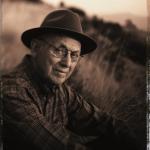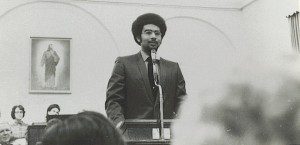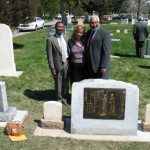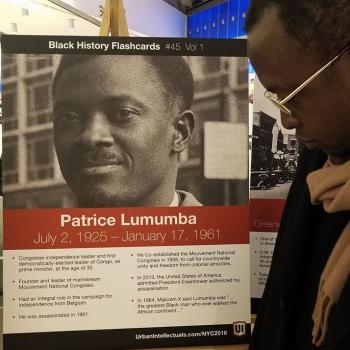“Margaret, are you gríeving
Over Golden grove unleaving?”
This is how Douglas Thayer often greeted me when we met in the hallway of the Jesse Knight Building, where both of us taught for years. I wonder if I was the only person who got such a greeting from his rich supply of poems. I was still in my twenties, newly married to Bruce Young, when he first greeted me this way—in 1985. I had taken advanced creative writing from him in 1978, but I’m not sure he remembered that.
I certainly remember it, though. I was deeply intimidated by him. I had already started my third-world adventures, and had taken only two books with me to Guatemala the previous summer: Moby Dick and Under the Cottonwoods—Doug’s first short story collection, his personal response to President Kimball’s plea for LDS art and literature which could rival the great works of the world. I had recognized Dr. Thayer’s talent, and found “The Clinic” in that collection to be one of the finest pieces I had read anywhere. It’s the story of a returned missionary/Viet Nam war veteran who has gone from hope in the gospel to horrors in the jungle, and visits “the clinic” as part of his recovery. The other stories in the collection were excellent as well, but “The Clinic” (which he would eventually expand into a novel titled The Tree House) moved me the way only great literature can. Surely this man had one of the finest minds and most expansive hearts in the literary world.
I would find out later that I was right in my assumptions about his mind and his heart, but the man I encountered in English 518 was sardonic, witty, and sometimes painfully direct. He would not tolerate the term “making love”, for example, if the characters doing it were not married. No, if they weren’t married, sex was fornication.
His gifts of charity were cloaked in his ironic responses to people and words. He was funny and he was normal. I would not have guessed just by seeing him that he had the depth of intellect and heart to write “The Clinic.” Indeed, his “common man” bearing was part of his charm.
I remember him asking us students, “Does anyone have a copy of ‘La Belle Dame Sans Merci’?”
I immediately opened my purse and started looking.
“What are you doing?” he asked.
“I’m checking to see if I have that poem.”
Douglas Thayer then gave me THE look. The Look that only those of us lucky enough to have received it can picture. It cannot happen on any face but Doug’s. The look lasts a full three seconds.
“You’re all English majors,” he said as The Look ended. “I thought one of you might have an anthology with the poem in it.” His lips fought an amused smile. He muttered something and shook his head. “Looking in your purse!”
Doug was my supervisor when I started teaching Freshman English in 1985, and he was aware that I was dating my former professor. Bruce Young and I announced our engagement just before the English Department awards banquet in March 1985. I had won an award for a short story, so it was a big night—and the English professors were thrilled that Bruce, age thirty-four, was going to marry.
After the banquet, Doug congratulated me. I assumed that his kind words referred to my engagement. “You already knew, right?” I said. “Well, of course I knew,” Doug answered (emphasizing KNEW in his inimitable way). “I made the list!”
Now it was my turn to give Doug a significant look—but mine was confused. “The list?”
“Oh!” he said. “Oh! You’re referring to something else, not your award! Are there wedding bells?”
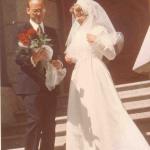 Of course, the idea of an “older” professor in BYU’s English Department getting married was quintessentially Doug’s and Donlu’s. Theirs was the romance of the English Department century. She was twenty-six and he was forty-five when they married in 1974—after a four-year courtship, and long past the time when anyone thought that Professor Thayer would marry.
Of course, the idea of an “older” professor in BYU’s English Department getting married was quintessentially Doug’s and Donlu’s. Theirs was the romance of the English Department century. She was twenty-six and he was forty-five when they married in 1974—after a four-year courtship, and long past the time when anyone thought that Professor Thayer would marry.
As Doug transitioned from being “Dr. Thayer” to Doug in my world, I found him wry and joyful, easily cajoled into wonderful, full-bodied laughter.
When I next saw him in the hall, after my marriage, he greeted me with Gerard Manley Hopkins’ lines for the first time: “’Margaret are you grieving?’ Do you know that poem, Margaret?”
I said that I did know it, but not well. His quoting it so often to me made me want to read it more deeply.
In 1989, Doug’s short story collection, Mr. Wahlquist in Yellowstone, was published. I eagerly recommended it to my students, particularly the story “The Red-Tailed Hawk,” which Gene England had called “the perfect story”. (Only six years ago, Doug published yet another acclaimed collection, Wasatch: Mormon Stories and a Novella.)
And so Doug Thayer and I became colleagues, and I remained his fan. He knew it, and thanked me periodically for recommending his work to my classes. When he published his memoir about growing up in Provo, Hooligan: A Mormon Boyhood, I recommended it to my family as well as to my students. I believe that my aunt Helen Dahlquist bought fifty copies. It was so familiar and true to her, as she had also been raised in Provo. And it was hilarious!
His stories and novels (the novels include Summer Fire and The Conversion of Jeff Williams as well as The Tree House) were full of his dry wit and keen observations of human nature, and some were very hard. His story, “Wolves!” which was recently anthologized in Dispensation (Angela Hallstrom, ed) depicted rape and slow recovery. It is a violent and disturbing story, and author Neal Chandler told me he thought it was the best thing Doug had yet written.
And there’s the essence of Doug’s writing life: He was still writing. He was always becoming a better writer.
The other parts of his life were also about growth and evolution, including the evolution of faith. When the mother of our colleague, Bruce Jorgensen, was in a care center, Doug began quietly visiting and comforting her. He and my husband gave her a blessing. This is one of many examples, most of which I only imagine, of Doug’s unheralded charity. It was a part of how Doug lived his life. He simply did good. No fanfare.
He enjoyed teaching his children the value of hard work, and insisted that lawn mowing include careful edging. (His sons had a lawn mowing business.) He loved them and was proud of them.
He loved Donlu. No fanfare.
I have some of my own stories in anthologies which feature Doug’s. What’s not written is what I write now: Without Douglas Heal Thayer, many of us Mormon writers would have lacked the mentoring we needed at the time when we needed it. Our stories might not have been written had Doug Thayer not written his. He was a teacher and an exemplar—beyond the classroom, and beyond the written text. He has been called (with Don Marshall) the vanguard of the “second generation” of LDS literature, coming after the “lost generation.” We who are now in our fifties and sixties were just coming of age when Doug taught us what a good “coming of age” story is. Many of us have gone on not only to write, but to teach. Whatever bit of light we have passed on to our students came, in part, from Douglas Thayer. The reflections of his bright star on the pages of Mormon literary history will go on forever. Those of us who knew him were blessed by this legacy, which we gratefully pass on.
Of course, I must finish with that line which I can imagine Angel Doug asking me at his funeral service: “Margaret, are you grieving?”
Oh yes. Yes, yes.


